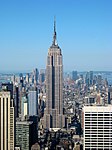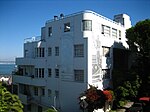Setback (architecture)

A setback, in the specific sense of a step-back, is a step-like form of a wall or other building frontage, also termed a recession or recessed story.[1] Importantly, one or more step-backs lowers the building's center of mass, making it more stable. A setback as a minimum one-bay indent across all stories is called a recessed bay or recess and is the more common exterior form of an alcove.
Notable upper stories forming a step-back may form a belvedere – and in residential use are considered the penthouse. If part of the roof, then they are a loft or attic/garret.
History
Setbacks were used by people to increase the height of
For centuries, setbacks were a structural necessity for virtually all multi-level load-bearing
The introduction of a

Setbacks and urban planning
Today many
In many cities, building setbacks add value to the interior real estate adjacent to the setback by creating usable exterior spaces. These setback
In the
-
Increasing setbacks make the Empire State Building in New York taper with height.
-
The Malloch Building in San Francisco is stepped back along the contour of the steep side of Telegraph Hill.
-
New York's Daily News Building features a number of setbacks. It was designed by architect Raymond Hood in 1929. The 1916 Zoning Resolution of New York led to many soaring, setbacked towers.
See also
- Height of Buildings Act of 1910 (Washington DC)
- Urban canyon
References
- ISBN 978-1-59339-492-9. Retrieved 3 March 2020.
- ^ Cornelius Steckner: Baurecht und Bauordnung. Architektur, Staatsmedizin und Umwelt bei Vitruv, in: Heiner Knell, Burkhardt Wesenberg (Hrsg.), Vitruv – Kolloquium 1982, Technische Hochschule Darmstadt 1984, S. 259–277.
- ^ ISBN 978-0-300-05536-8.
- ^ "Zoning Glossary - DCP". www1.nyc.gov. Retrieved 2020-10-11.
- ISBN 978-1-61044-550-4. Retrieved 3 March 2020.
Further reading
- Alexander, Christopher. A Pattern Language. Oxford University Press, 1977.
- Koolhaas, Rem. Delirious New York. Monacceli Press, reprint 1997.



